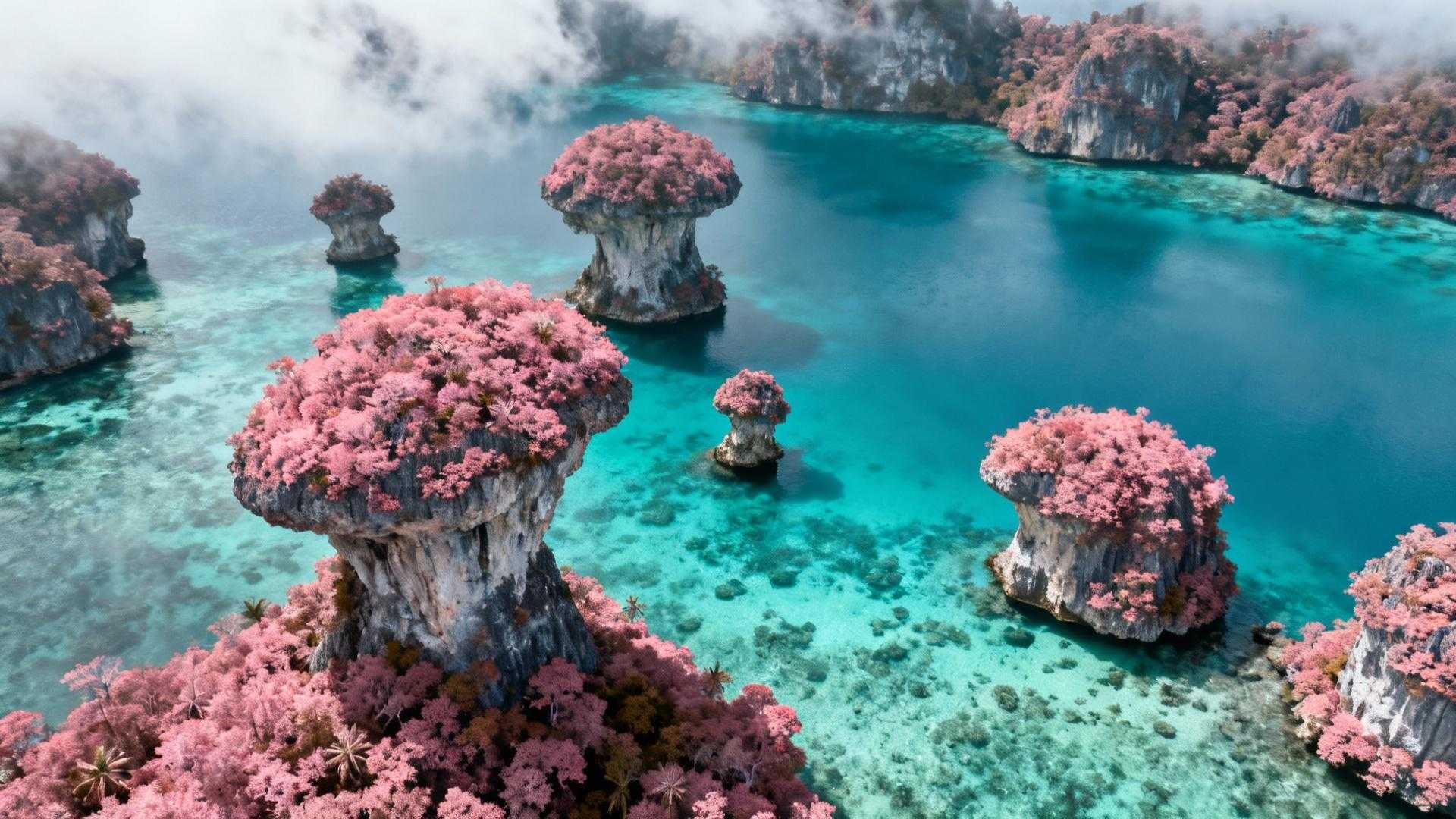I still remember the moment I slipped into the warm water of Jellyfish Lake, surrounded by thousands of golden jellyfish pulsing gently around me—completely harmless, impossibly beautiful. That afternoon in Palau’s Rock Islands changed everything I thought I knew about tropical paradises. While everyone chases overwater bungalows in the Maldives, 445 uninhabited limestone islands rise from this UNESCO-protected lagoon like emerald mushrooms, hiding marine lakes and underwater caves that exist nowhere else on Earth.
The Palauan people call this archipelago Chelbacheb, and locals have protected it for millennia before UNESCO recognized it as a World Heritage Site in 2012. This isn’t just another tropical destination—it’s legitimately ranked as one of the Seven Underwater Wonders of the World, yet somehow it remains beautifully forgotten by mass tourism.
The singular lagoon where mushroom islands guard marine treasures
Why 445 limestone islands create unrepeatable biodiversity
The Rock Islands Southern Lagoon spans 100,200 hectares of protected waters, where volcanic limestone islands have eroded into distinctive mushroom shapes over millennia. These formations create sheltered coves and marine lakes that house species found literally nowhere else on the planet. Scientists have documented over 385 coral species and 13+ shark species thriving in these waters—a concentration of marine life that rivals Raja Ampat without the diving crowds.
The stingless jellyfish phenomenon that defies marine biology
More than 50 marine lakes dot the Rock Islands, including the famous Jellyfish Lake where millions of golden jellyfish have evolved without stingers over 12,000 years of isolation. Swimming through clouds of these harmless creatures feels like floating through an aquarium designed by nature herself. Clear Lake and Uet era Ongael offer similar encounters with species that exist in these enclosed ecosystems alone, making every snorkel session a brush with evolutionary uniqueness.
The mandatory pledge that protects what the Maldives commercialized
How Palau pioneered immigration policy for environmental protection
Every visitor to Palau must sign the Palau Pledge upon arrival—stamped directly into your passport. Launched in 2017 and co-created with local schoolchildren, this world-first environmental immigration policy reads: “I vow to tread lightly, act kindly and explore mindfully.” It’s not performative eco-tourism; rangers enforce sunscreen bans (only reef-safe mineral formulas allowed), boat operation rules, and visitor limits that keep the lagoon pristine.
The permit system that ensures you’ll never see Instagram crowds
Unlike this uninhabited BVI islet that looks like the Maldives but costs 80% less, Palau requires permits managed by Koror State Rangers under the Rock Islands Use Act. The $30 Green Fee and $20 departure tax fund conservation programs that have kept the lagoon essentially unchanged since the 1990s. You’ll share these emerald islands with maybe a dozen other boats instead of hundreds of Maldivian speedboats ferrying resort guests.
Why spending $150 per night in Koror beats $600 Maldivian overwater villas
The biodiversity advantage mass tourism destroys
While Maldivian resorts bulldoze reefs for overwater construction, Palau’s accommodation stays on the main island of Koror, leaving the Rock Islands completely uninhabited. Day tours by kayak or boat reveal 3,000-4,000-year-old pictographs in burial caves, WWII wreck diving sites, and beaches where endangered hawksbill turtles nest without disturbance. Just as this tiny Grenada isle preserves Caribbean cultural authenticity, Palau protects Pacific marine heritage through genuine conservation rather than resort branding.
The authentic cultural immersion luxury resorts can’t replicate
The 680 Night Market in Koror offers traditional Palauan dancing and tapioca coconut cream desserts for dollars, not resort mark-ups. Local wood carvers still work mahogany using techniques passed down for generations, and fishing communities practice sustainable harvesting methods developed centuries before Western tourism arrived. This cultural depth simply doesn’t exist in manufactured resort islands.
The November-June window that delivers perfect visibility
Why October shoulder season offers the smartest value
Palau’s dry season runs November through June, delivering calm seas and 100-foot visibility for snorkeling and diving. October sits in the shoulder season sweet spot—weather transitioning to dry conditions, crowds still minimal, and accommodation rates 20-30% lower than peak December-March pricing. Similar to how Kai Bae offers national park trails for 70% less than Phuket, Palau delivers UNESCO-protected marine experiences without high-season premiums.
The cultural calendar that adds deeper meaning to visits
Beyond weather optimization, visiting during traditional fishing seasons lets you witness sustainable harvesting practices in action. The 2021 coastal fisheries management plan guides reef fish and invertebrate population restoration while communities continue cultural practices tied to lunar cycles and migration patterns—experiences no Maldivian resort can manufacture.
Essential questions about visiting Palau’s forgotten wonder
Do US, UK, and Australian citizens need visas for Palau?
No visa required for tourism stays up to 30 days, though you must sign the mandatory Palau Pledge stamped in your passport upon arrival. The pledge commits visitors to environmental and cultural respect throughout their stay.
How do you actually reach the Rock Islands from Koror?
Day tours depart Koror by boat or kayak, ranging from half-day snorkel trips to multi-day camping expeditions. Local operators provide all equipment and guide services, with permits included in tour costs. Independent exploration requires separate permit applications through Koror State.
Is Jellyfish Lake always accessible for swimming?
Jellyfish populations fluctuate naturally with El Niño patterns and seasonal conditions. Check current status before booking, as temporary closures protect regenerating populations. Multiple marine lakes offer backup snorkeling when Jellyfish Lake needs rest.
The Rock Islands Southern Lagoon proves that true luxury isn’t overwater villa Instagram shots—it’s swimming with stingless jellyfish in lakes that exist nowhere else, exploring uninhabited islands protected by communities who’ve stewarded them for millennia, and experiencing biodiversity that makes marine biologists weep. While the Maldives sells you manufactured paradise, Palau invites you to protect the real thing.
